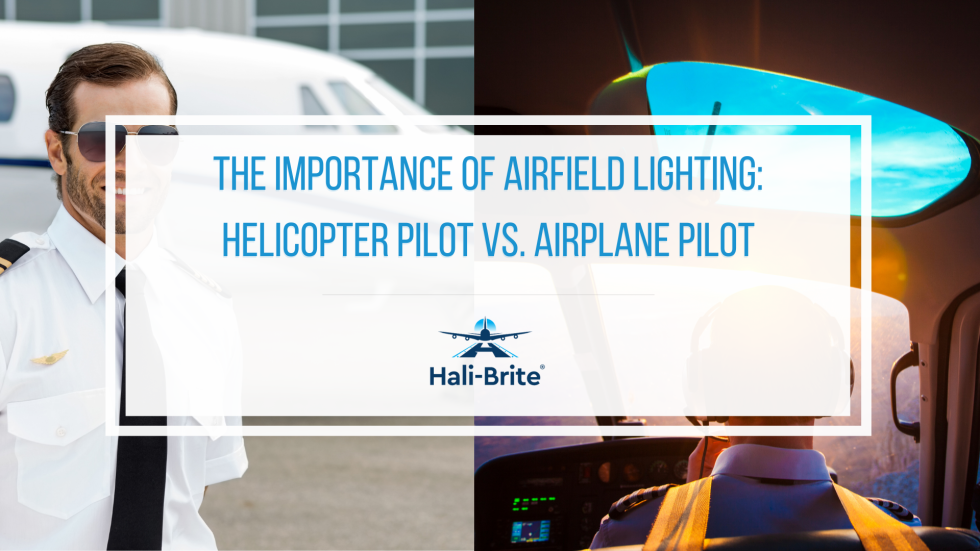Although helicopter and airplane pilots fly different aircraft, they both require lighting aids as guidance during night flights. However, unlike the standard airport lighting aids utilized by airport pilots, helicopter pilots use heliport lighting equipment specifically designed for helicopter operations. Here, you’ll learn the difference between helicopter and airplane pilots and how airfield lightings help them when flying an aircraft.
Overview: Helicopter vs Airplane Pilots
Helicopters and airplanes are different types of aircraft, each with a distinct flying mechanism. Helicopters use spinning rotor blades to take flight, while airplanes rely on steady airflow across their fixed wings to generate lift.
Since each aircraft is operated differently, the license standards, including aeronautical knowledge and experience, between helicopter and airplane pilots also vary. Let’s get to know the similarities and differences in FAA certificate requirements between a helicopter pilot and an airplane pilot.
Student Pilot Certificate
Before getting a pilot license for any type of aircraft, you must first have a student pilot certificate. But you don’t need to acquire one to take flight lessons – a student pilot certificate, along with a medical certificate, is only necessary once you start doing solo flight training.
To be eligible for a student pilot certificate, you simply need to be:
- At least 16 years old
- Able to read, speak, write, and understand the English language
In order to get your student pilot certificate and operate an aircraft on a solo flight, you need to pass the aeronautical knowledge test and demonstrate satisfactory proficiency and safety on maneuvers and procedures.
Private Pilot License
Having a private pilot license allows you to buy or rent an aircraft and fly it for personal use. However, you cannot operate it for commercial purposes. Overall, becoming a private pilot of either an airplane or helicopter has similar requirements.
To obtain a private pilot certificate, you must:
- Be at least 17 years old
- Have either recreational pilot certification, sport pilot certification, or student pilot certification
- Have 35 hours of aeronautical knowledge training
- Have 20 hours of flight training from an authorized flight instructor, which includes:
- 3 hours of cross-country flight training in a helicopter
- 3 hours of night flight training
- One cross-country flight
- 10 takeoffs and 10 landings to a full stop
- 3 hours of flight training on control and maneuvering (for airplanes)
- 3 hours of flight training within 60 days prior to the practical test
- 5 hours of solo flight training in a helicopter with at least:
- One cross-country flight
- 3 takeoffs and 3 landings to a full stop
- Pass the knowledge test
- Pass the practical test
Commercial Pilot License
Making money as a pilot requires a commercial pilot license. Commercial pilots are authorized to do any aviation activity, except airline transport, for compensation.
Here is the difference in the commercial certificate requirements between a helicopter pilot and an airplane pilot:
| Helicopter Pilots | Airplane Pilots |
|
|
Airline Pilot License
Acquiring an airline transport pilot license enables you to fly an aircraft with passengers in scheduled airline operations. The airline transport pilot certificate has the most demanding aeronautical training and experience qualifications among the other pilot licenses.
Here is a comparison of airline certificate requirements between a helicopter pilot and an airplane pilot:
| Helicopter Pilots | Airplane Pilots |
|
|
How Dependent Are Pilots on Lighting
The FAA requires both heliports and airports to install navigational lighting aids to ensure safety during aircraft operations. Lighting aids help pilots fly safely at night or in low visibility conditions. Rotating beacons, for example, allow pilots to pinpoint heliport or airport locations while navigating.
In heliports, the FATO and TLOF perimeter lights enable helicopter pilots to locate the exact landing area. At the same time, airports rely on runway and taxiway lights, such as Hali-Brite’s L-860 Low-Intensity Elevated Runway, to guide airplane pilots during landing, takeoff, and taxiing.
Improve Your Airport Today
For your navigational lighting needs, whether it’s heliport lighting or airport lighting, Hali-Brite is here to assist you. We have FAA-certified lighting solutions that can illuminate your heliport or airport at night, keeping everyone in the area safe during flight operations. Call us at (218) 454-0956 or contact us here.


